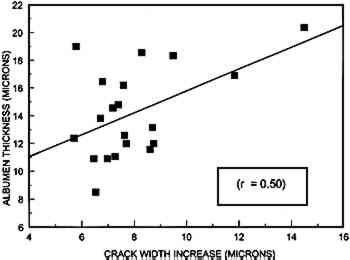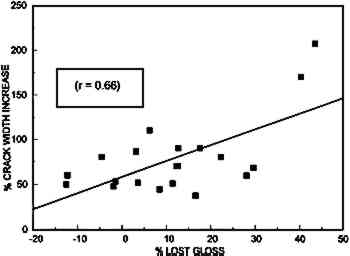EFFECTS OF AQUEOUS TREATMENT ON ALBUMEN PHOTOGRAPHSPAUL MESSIER, & TIMOTHY VITALE
4 DISCUSSION4.1 NOTE ON USE OF BLOTTERSChange in gloss due to contact of wet prints with blotter paper merits consideration. The results of the experiment indicate the effect of blotters on gloss appears to be minimal. Table 4 shows even though blotters were not used on the mounted prints after surface cleaning (see section 2.2), loss of gloss is exactly the same for the air-dried and blotter-dried samples. It can be concluded, therefore, that the use of blotters had no effect in altering gloss. A possibility also exists that immersion causes a greater degree of swelling and softening of the albumen as compared to surface cleaning (see section 2.2). If the albumen layer is softened substantially more by immersion, then the surface of the albumen layer could be altered by the use of blotters during drying. However, there was no overt evidence of this effect observed during the project. Cumulative treatment experience indicates that the surfaces of wet, historical albumen prints never stick to blotters during drying. In Vitale and Messier (1994) the literature concerning silver hardening of the albumen layer during sensitization is reviewed. Though not quantified, the historical and anecdotal information from albumen print makers affirm that sensitized albumen layers are reasonably tough when wet. These observations, taken with the heavy metal sequestering action of the sulfhydryl groups and pendant oxygen and nitrogen, suggest that silver sequestering is the probable cause of the “hardened” behavior. 4.2 INTEGRATION OF RESULTSWhen the initial gloss of all 20 prints is averaged, there is no link between gloss and albumen thickness. This fact contradicts the accepted wisdom that thicker albumen coatings yield a glossier surface. When the mounted and never-mounted photographs are considered as separate populations, a relationship emerges. Figure 5 shows that thicker albumen coatings result in a glossier prints within mounted or never-mounted groups. The low r values (r = 0.37 for mounted photographs, r = 0.70 for never-mounted photographs) reflect the fact that the data are from historical artifacts that have numerous variables built in during manufacture and that other variables that can intervene
Figure 6 shows the relationship between albumen thickness and crack width increase. Although logical to assume such a relationship exists, the presence of other variables appears to deter a stronger relationship. The plot (r = 0.50) suggests that thicker albumen coatings generally exhibit a greater degree of cracking after aqueous treatment. However, deviation of individuals from the plotted regression (mean) suggests the unknown histories of individual prints play an important factor.
Figure 7 shows the relationship between albumen crack width increase and loss in gloss. Undoubtedly surface cleaning removes dust particles and loosely imbedded particles, which would scatter light, and this change results in some increase in gloss. It is also reasonable to expect that immersion frees up additional particles that are lodged between cracks in the albumen layer. The switching of two prints into the gloss-increased group after their gloss had decreased slightly during surface cleaning (as noted in section 3.3.2) is most likely explained by the opposing effects of crack width increase that decreases gloss and dirt removal that increases gloss. It must be noted, however, that the prints with increases in gloss do not correspond to those prints that show substantial increase in highlight lightness, L∗ (see table 7). Factors other than dirt removal must contribute to increase in gloss.
Gloss decrease would appear to be due to the massive, 69% increase in crack width (see table 2) and the 41% increase in crack population (see table 3). The average crack expands from 11.7 μm to 19.7 μm, and this expansion occurs for an average of 1 million cracks in an 8 � 10 in. print. Based on an 8 � 10 in. print, there are an average 410,000 additional cracks. Several practical factors must also contribute to increased light scattering, such as (1) the albumen segments between cracks probably curl up after wetting and drying (as illustrated in environmental scanning electron microscope experiment shown in Messier and Vitale 1993b), thereby deflecting light; and (2) the artifacts used for the study have unknown manufacture and storage histories. Statistical relationships plotted in this research use standard linear least squares regression mathematics to create a best fit line (Lotus 123, Release 3.1). The use of linear regressions was chosen for the sake of uniformity. Since the sample populations are relatively small, use of other types of regression calculations seemed unwarranted. It should be noted, however, that the existence of logarithmic or exponential relationships should not be ruled out, especially when there are limiting factors. 4.3 INTERPRETATION OF COLOR RESULTSSlight color changes were measured in the image highlights, medium density, and maximum density areas. These changes are primarily attributable to the removal of dirt. A layer of dirt behaves much like a neutral-density filter; each wavelength in the visible spectrum receives a slight boost in reflectance when it is removed. The slight increases in all three of the CIE L∗a∗b∗ parameters (L∗ lightness, a∗ redness, and b∗ yellowness) should be interpreted as an increase resulting from a slight increase in reflectance for all wavelengths. One cannot observe an increase in yellowness and redness while ignoring the increase in lightness. The increases in both spectral reflectance and CIE L∗a∗b∗ are congruent. The relatively large gains in spectral reflectance after 500 nm for the mounted prints (fig. 4) are statistically significant, as are the CIE L∗a∗b∗ data for some of the prints (summarized in tables 5, 6, and 7). Mounts used for albumen prints are often paperboard with paper exteriors Though proteins are slowly soluble in water, the fact that the after-treatment curves in figures 3 and 4 are similar in shape to the before-treatment curves indicates that no major chromophoric components were removed during a 1–4 hour immersion. If that were the case, the after treatment curve would have a pronounced dip in the yellow region or bump in the blue region (for example), corresponding with the reflectance of the material removed. 4.4 SUMMARY OF RESULTSALBUMEN THICKNESS
PRINT DIMENSIONS
GLOSS
CRACK WIDTH
CRACK POPULATION
COLOR
|


